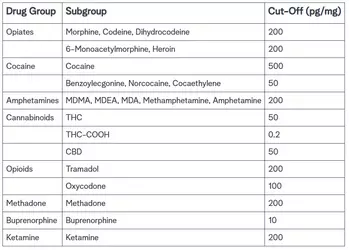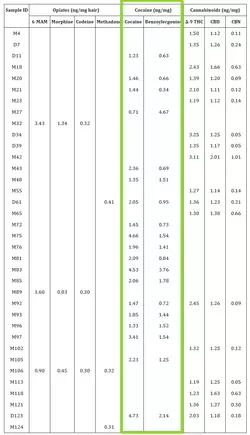Is this the 1 in 5 research NIck is referring to?
https://pmc.ncbi.nlm.nih.gov/articles/PMC3945599/
Who knows?
Hair testing was used to investigate the prevalence of unsuspected exposure to drugs of abuse in a group of children presenting to an urban paediatric emergency department without suggestive signs or symptoms. Hair samples were obtained from 114 children between 24 months and 10 years of age attending the emergency room of Hospital del Mar in Barcelona, Spain.
The subjects were children admitted to the paediatric department, already it'll be disingenuous to extrapolate this onto the entire population, most of which don't do drugs nor do they abuse their children.
The samples were analyzed for the presence of opiates, cocaine, amphetamines, and cannabinoids by ultra-performance liquid chromatography-tandem mass spectrometry.
They're looking at more than just cocaine though, so skelly already lied if this were the "study" he's trying to cite. He said cocaine only. Also, they're using UPLC-MS/MS, not GC-MS.
Were they using a cut-off? Nope.
Hair samples from twenty-three children (20.1%) were positive for cocaine (concentration range 0.15–3.81 ng/mg hair), those of thirteen children (11.4%) to cannabinoids (Δ9-THC concentration range 0.05–0.54 ng/mg hair), with four samples positive to codeine (0.1–0.25 ng/mg hair), one positive for 2.09 ng methadone per mg hair and one to 6-MAM (0.42 ng/mg hair) and morphine (0. 15 ng/mg hair) .
| Narcotic or metabolite | Count | percent | Concentration |
| Cocaine | 23 | 20.1% | 150-3810pg/mg |
| Δ9-THC | 13 | 11.4% | 50-540pg/mg |
| codeine | 4 | 100-250pg/mg |
| methadone | 1 | 2090pg/mg |
| 6-MAM | 1 | 420pg/mg |
| Morphine | 1 | 150pg/mg |
Here's the cut-off commonly used:

See the numbers? A lot of them falls under the cut-off or
tested positive borderline.
That's what I've been saying. Only one kid tested positive with cut-off referenced. The other 4 could have tested positive too, but the results were below cut-off.
This isn't really the own he thinks it is and he shouldn't be citing this study.
In 69.5 and 69.2% of the positive cocaine and cannabinoids cases respectively, drugs was also found in the hair of accompanying parent.
70% of those tested positive for cocaine and cannabinoids had likely user parents.
This study was conducted in the Paediatric Emergency Department of the Hospital del Mar of Barcelona, Spain, between March and April 2013. The hospital is located in an urban area with low socioeconomic status and a high percentage (more than 40%) of immigrants.
This hospital is located in an area of lower socioeconomic status, not some rich urban neighbourhood which would have been more applicable to this skeleton.
Why don't we look at cocaine?

The highest recoded for cocaine was 4.73ng/mg which is 4730pg/mg.
The highest recoded for benzoylecgonine was M27 at 4670pg/mg. This result is weird as the kid only tested positive for cocaine at 710pg/mg, that is barely above cut-off. It could be contamination. However, we know skelly's daughter A.R.R. tested positive for COCAINE at 5000pg/mg, as the reports references a cut-off value of 500, used for cocaine, not benzoylecgonine. We know by his own admission that she tested positive for benzoylecgonine as well.
That's right, none of them tested positive for cocaine at >5000pg/mg.
A.R.R. has a grim future.

While it has been proved that acute exposure to cocaine during childhood is associated with neurologic manifestations such as focal and generalized seizures in children eight years of age and younger and alterations in mental status, including delirium stupor and coma in older children, and even death in cases of oral or inhaled routes of intoxication, the long term effects of a repeated postnatal exposure to cocaine have not been clarified yet.
I'm still waiting for your 40 abstracts cope stream sponsored by Quora.
Since hair testing for drugs of abuse is still an expensive test due to the required specific skills and instrumentation, unfortunately it cannot be proposed as a general screening for the paediatric population. As maximum cost benefit ratio, we advocate performing this test in the paediatric population attending emergency wards or general hospital for any complaint when:
-
the hospital is located in a area of very high percentage of drug consumption and socioeconomic difficulties;
-
there is clinical suspicion of acute intoxication from any possible drug in the child;
-
there is a clinical suspicion of chronic intoxication from any possible drug in the child;
-
there is a suspicion or evidence or declaration of drug addiction in the accompanying parent;
-
there is evidence of a risky environment around the child.
Specific social and health interventions towards exposed children and their families may help in preventing and treating possible intellectual, emotional-behavioural and neurologic disorders in the exposed children. This strategy can also lead to educating and counselling parents on potentially deleterious effects of drugs of abuse available and consumed at home even if it is done not in the presence of the children.
I'll laugh my fucking arse off if he used this "study" to show 20% of children are exposed to narcotics at a level that can be picked up by mass spectroscopy.

